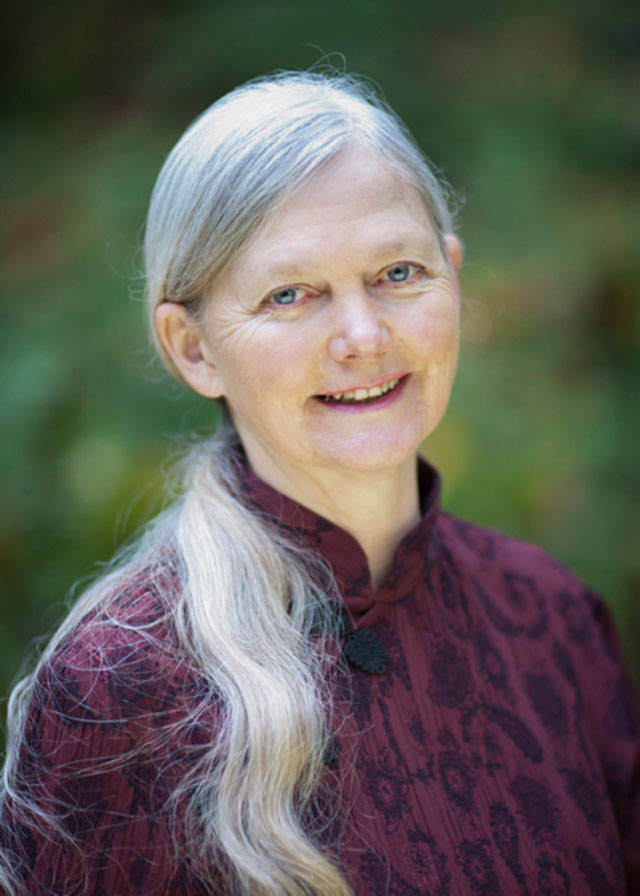Goin’ home, goin’ home, by the riverside I will rest my bones,
Listen to the river sing sweet songs, to rock my soul.
I can imagine salmon humming this Grateful Dead lyric to themselves as they work their way back to us. Salmon and the fall rains have been on my mind a lot in recent weeks.
Bianca Perla of the Vashon Nature Center, Michael Laurie and I watched the weather forecasts intently, waiting for the first big rainfall. When it came in mid-September, the three of us met up early on a Sunday morning, as the rain washed some of summer’s build up of pollutants off our streets, parking lots and properties into the streams. We spent the next three hours carefully collecting water samples from several key spots in the Shinglemill Creek watershed.
Why were we doing this? Our water sampling is part of a project to test stormwater run-off for pollutants that harm salmon that use our streams, and by default, our resident orcas, which need salmon to survive. The water that washes off roads can contain oil and metal pollutants. The run-off from lawns, gardens and farms can contain pesticides (insecticides, herbicides and more). The samples will be tested for the contaminants most harmful to salmon.
Because Michael and I work specifically to reduce the use of toxic pesticides, I will focus this article on two of the worst pesticides for salmon that you may be familiar with: Weed and Feed (2,4-D) and Preen Weed Preventer (trifluralin). Both of these chemicals are toxic to salmon and the aquatic invertebrates that hatchling salmon eat.
2,4-D is used to kill broadleaf plants in lawns. It is the ‘Weed’ in ‘Weed and Feed” products. This herbicide is not only toxic to salmon; it is also toxic to humans and their pets. A study found that the 2,4-D levels inside homes were about 10 times higher after it was applied to the lawn than before application. The highest levels were found inside homes with children and a dog. This is because once they are tracked inside, these toxic chemicals can no longer be broken down by sunlight and soil organisms, so they last much longer than they would outdoors. Several studies have found higher levels of pesticides indoors in the carpets and dust than in the soil outdoors. Young children who spend time playing on the floor are most at risk.
The trifluralin in Preen’s ‘Weed Preventer’ stops seeds from sprouting, and large quantities are needed to do this job: 2/3 cup of Preen for 50 square feet of garden, applied repeatedly through the year. It is the largest pesticide container you will see in the pesticide aisle. Trifluralin, the active ingredient, is very toxic to salmon. A few hours of exposure to less than a teaspoon of trifluralin in 660,000 gallons (an Olympic swimming pool of water) can cause deformities in fish. Island Lumber took products containing trifluralin off its shelves a couple of years ago for this reason. Only Ace still carries it on the island.
At this point you may be saying: “OK. I get it that 2,4-D and Trifluralin is bad stuff. But what am I to do about the weeds? The lawn has not come back nearly as fast as the weeds have.”
Not to worry. There are alternatives.
If you want a healthier, thicker lawn, early to mid-October is a great time to top-dress with a half inch of organic compost, and overseed with a drought-tolerant grass mix containing ryegrass and fine fescue. Or, you can embrace the concept of an eco-lawn, as the Vashon High School has done, and add clover, yarrow and Bellis perennis to the seed mix. This particular combination, called Fleur de Lawn, is available at The Country Store & Farm.
If you have been using Trifluralin to keep weed seeds from sprouting, you can switch to corn gluten meal — an organic alternative discovered by (wait for it) Iowa State University. This organic alternative weed preventer is available at both Ace and Island Home Center & Lumber.
These safer alternatives will get the job done and will not be a problem in our stormwater, aquifer and salmon streams.
Our stormwater testing is a local community science effort. We will share what we learn about Shinglemill as results come in. Stay tuned, and welcome the salmon home.
— Diane Emerson is part of Garden Green, a local effort to reduce the use of toxic pesticides.



